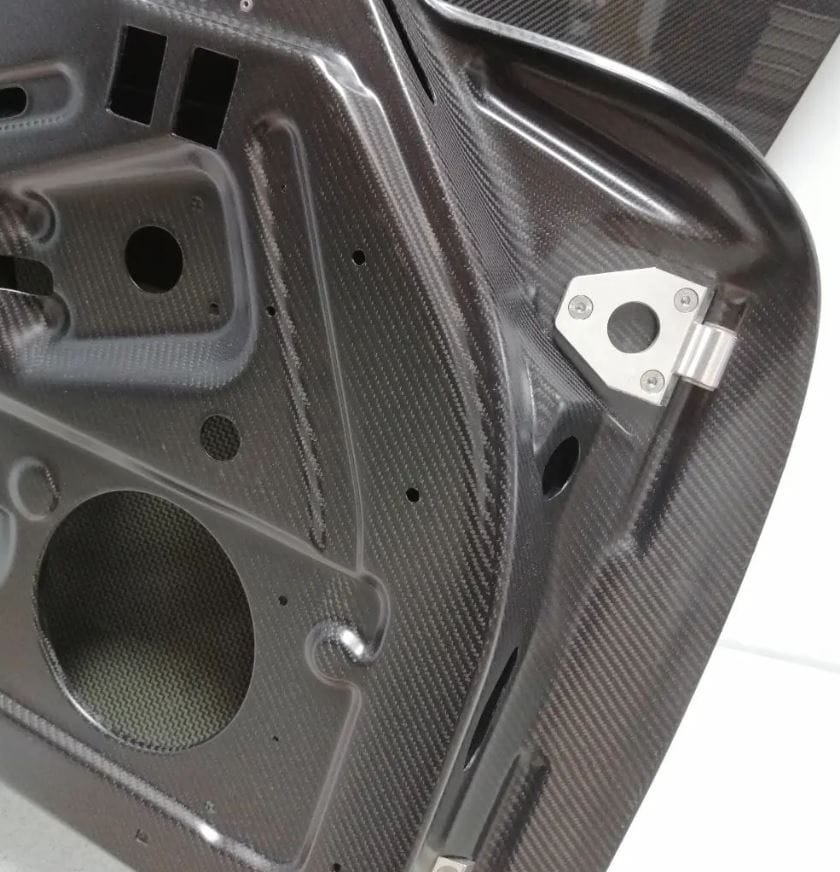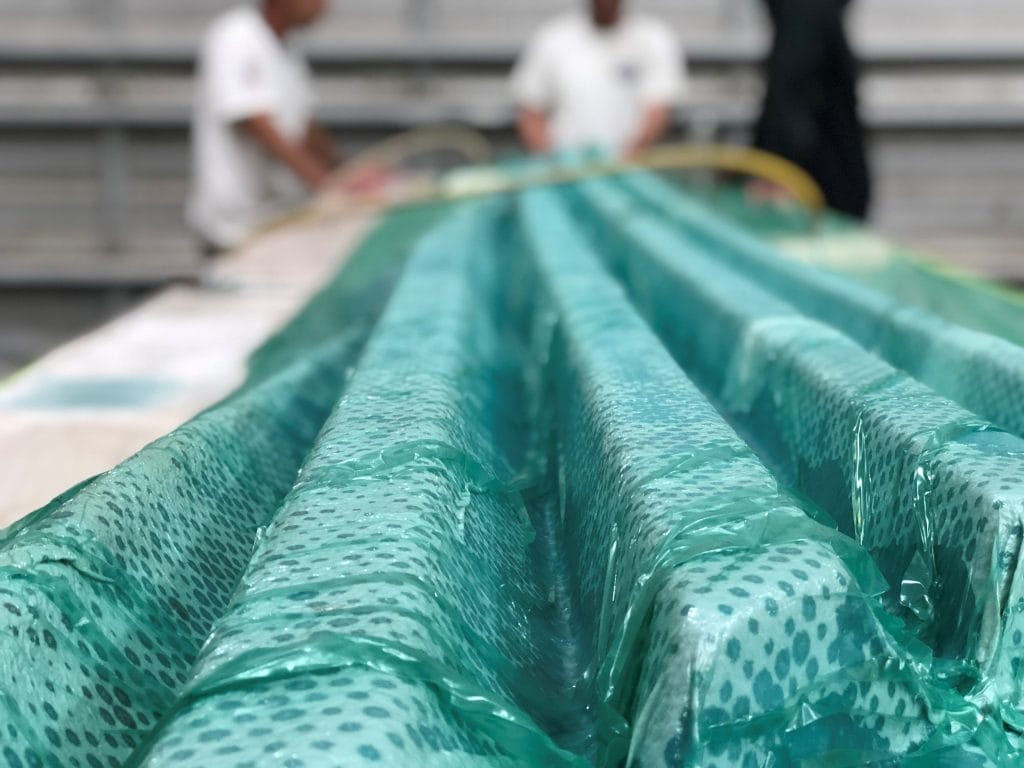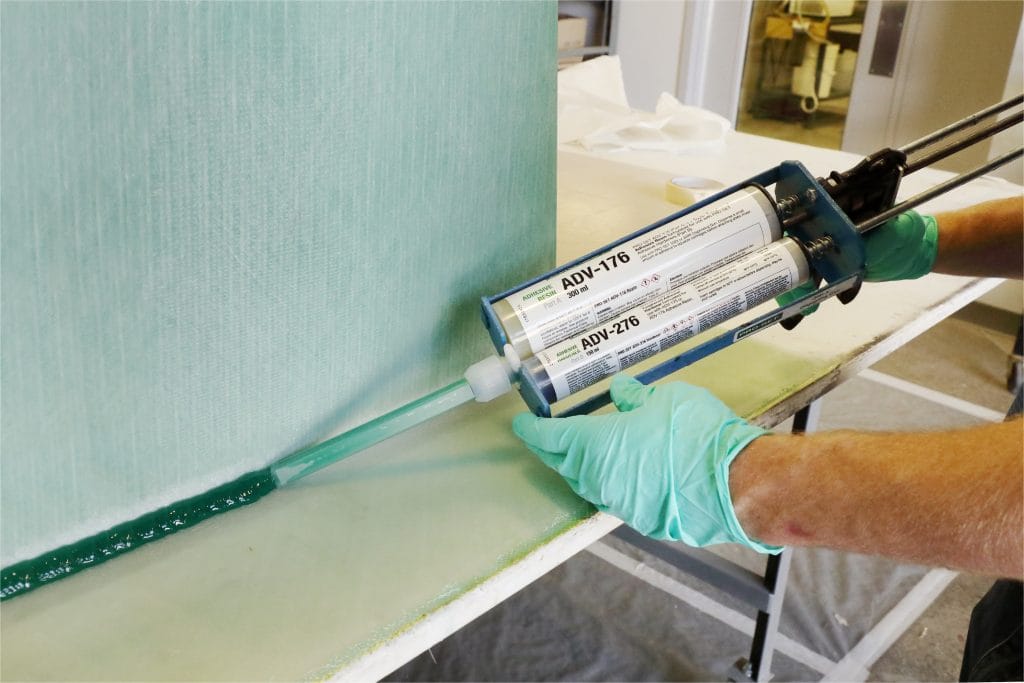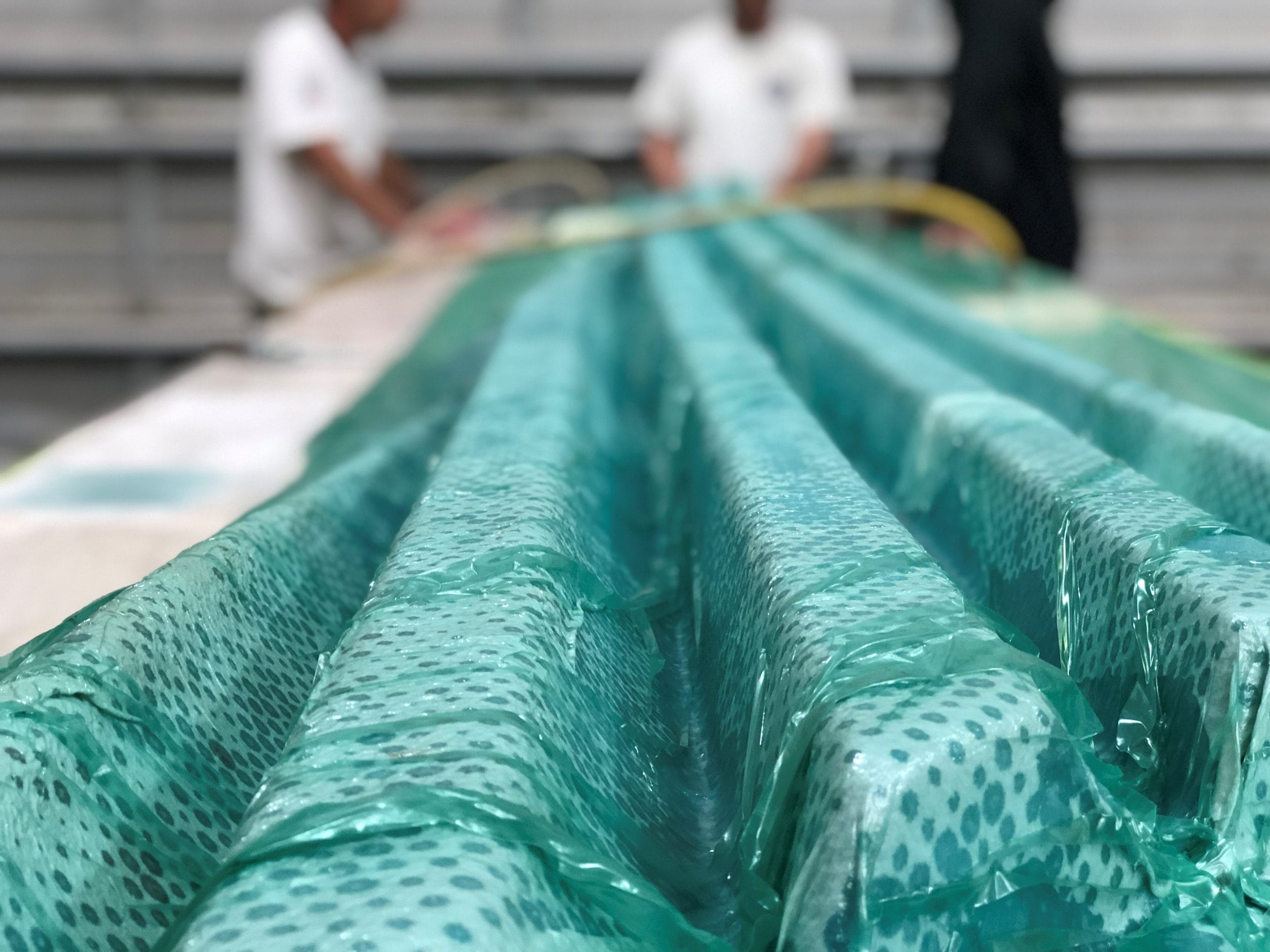
Application Techniques
Photography Credit J-TEC Composites Ltd.
Primary Bonding/Wet Lay-Up
PRO-SET® Laminating Epoxies are specifically formulated for bonding composite materials such as fibreglass, carbon, aramid, and core materials. Fabrics can be saturated by hand or by using roller-impregnating machines. Due to variations in viscosity among resin/hardener combinations, it is important to test each combination with a specific fabric and impregnating machine setup to ensure compatibility.
Fabrics recommended for use with PRO-SET® Epoxies should be epoxy-compatible. Avoid fabrics with styrene-soluble binders or those only compatible with styrene resins.
Infusion
PRO-SET® Infusion Epoxies are utilised for resin infusion, VARTM, RTM, and other closed moulding applications. Selecting the resin/hardener combination that will offer the correct gel time for the specific part and process is important. Due to the numerous variables at play, these techniques necessitate testing to identify the most appropriate procedure and resin/hardener combination for each part.

Vacuum Bag Laminating
Vacuum bagging is an excellent clamping method for composite construction using PRO-SET® Laminating Epoxies. By regulating the vacuum pressure, you can control the resin/fibre ratio and create a denser laminate with a higher fibre volume. Generally, higher vacuum pressure results in lower resin content. A component’s optimal resin/fibre ratio typically falls between 30% and 50%. A lower ratio produces a lighter composite, while a higher ratio yields a heavier yet more moisture-resistant one. The choice of bleeder and absorber materials in vacuum bag laminating can also impact the resin/fibre ratio. Building test panels to determine the appropriate vacuum bagging material schedule and pressure for a specific component is advisable.
Release Fabric
When performing secondary bonding or applying additional coatings in specific areas, it is recommended to use a release fabric (such as peel ply) over the lay-up. When peeled from the cured or partially cured surface, this release fabric leaves a smooth texture free of contaminants and amine blush. Once the laminate reaches the initial cure and the release fabric is removed, the surface is primed for bonding without further preparation. Utilising release fabric eliminates the necessity for washing and sanding before secondary bonding or coating.
A laminate can be constructed through multiple lay-ups over several days. After each day’s lay-up, apply the release fabric and remove it before the next lay-up. Upon completion, the layers of laminate can be post-cured together.
It is important to note that not all release fabrics have an epoxy-compatible coating or a texture suitable for secondary bonding with epoxy. Before constructing a part, conduct a bonding test on a surface prepared with the intended release fabric at the proposed post-cure temperature to ensure compatibility.
Surface Preparation
The success of secondary bonding depends not only on the strength of the epoxy but also on its ability to mechanically key into the material’s surface rather than chemically bond to it. If you are bonding to a surface that has not been properly prepared with release fabric, the following surface preparation steps are critical for any secondary bonding:
1. Removing Amine Blush
Amine blush is a by-product of the epoxy curing process, forming a wax-like film during the initial cure phase. This water-soluble film can be easily removed, but if left unattended, it may clog sandpaper and hinder subsequent bonding. Clean the surface with water and an abrasive pad, such as 3-M Scotch-Brite™ 7447 General Purpose Hand Pads, to eliminate the blush. Dry the surface with plain white paper towels to prevent the blush from drying on the surface. After washing, the surface should appear dull. Address any remaining glossy areas by sanding with 80-grit sandpaper. If a release fabric is used, the amine blush is removed when the release fabric is taken off.
2. Cleaning
Surfaces must be free of any contaminants, such as grease, oil, wax, or mould release. Clean contaminated surfaces with silicone and wax remover or acetone. Wipe the surface with clean paper towels before the solvent dries. Clean surfaces before sanding to avoid sanding the contaminant into the surface.
CAUTION: Provide plenty of ventilation and follow all safety precautions when using solvents.
3. Drying
For optimal adhesion, ensure that bonding surfaces are as dry as possible. If needed, speed up the drying process by warming the surfaces with hot air guns or heat lamps. In confined spaces, use fans to circulate the air. Be mindful of condensation when working outdoors or when there are fluctuations in the temperature of the work environment.
4. Sanding
Sand non-porous surfaces (such as metal, FRP laminate, cured epoxy, hardwoods, etc.) thoroughly to achieve an abraded surface. Using 80-grit aluminium oxide paper will create a suitable texture for the epoxy to adhere to. Ensure that the surface to be bonded is firm. Before sanding, remove any flaking, chalking, or blistering. Remember to wear a dust mask during this process. After sanding, make sure to remove all dust. For laminated surfaces, textured finishes can be achieved using release fabric during fabrication, potentially reducing the need for additional sanding.

Secondary Bonding
Secondary bonding operations involve bonding structural members, blocking or adding fabric reinforcement, coating, fairing, or filleting a previously cured or existing part. When the part has solidified, applying new epoxy will not chemically bond with it. Therefore, the component’s surface must be washed and sanded (if not prepared with release fabric) to ensure the proper surface for mechanical secondary bonds.
PRO-SET® adhesive is a two-part, thixotropic epoxy adhesive designed for secondary bonding and assembling composite components. It fully cures at room temperature and can undergo post-curing if parts need assembly before post-curing.
PRO-SET® laminating resins and hardeners are suitable for tabbing and taping operations before or after post-cure. To prevent excessive drainage, select the resin and hardener combination based on the required viscosity, cure speed, and fabric type.

Surface Preparation for Paint
Sand the surface while wet to remove any flaws and create a texture for the paint to adhere to. If using a filling or sandable primer, use 100-grit paper; if no primer is used, use 220-320-grit paper. The finer the sandpaper grit needed, the thinner the paint film thickness. After sanding, rinse the surface with clean water and ensure it dries completely. The rinse water should sheet without beading up or fish-eyeing, indicating potential contamination.
If needed, re-wash with solvent and wet-sand again. Allow the surface to dry thoroughly before painting. PRO-SET® Epoxies is an excellent base for most paint systems, with linear polyurethane paints offering the most durable protection over epoxy. Regardless of the paint system chosen, thorough surface preparation is crucial for optimal paint adhesion and a smooth finish. Follow the paint manufacturer’s instructions for coating.
Gelcoats
We have achieved positive results using various in-mould polyester gelcoats. Due to their superior resistance to ultraviolet degradation, polyester gel coats are preferred over epoxy gel coats for exterior finish applications. Please consult your polyester gelcoat supplier for recommendations and conduct tests to determine product suitability with epoxy and application techniques.
Some fabricators successfully sprayed a two-part linear polyurethane paint onto the mould surface. This coating is allowed to cure before the epoxy laminate is applied directly to it. Sometimes, an epoxy gel coat is preferred for plugs and moulds.
We advise testing each brand of gel coat, in-mould coating, and/or tie coat technique for suitability in a specific application. For custom product recommendations, please contact the PRO-SET® Technical Staff.

Our Experienced Team is Available to Help
